Dear foreign readers, attending Simbang Gabi1 is a tradition among Filipinos and involves 9 novena-dawn masses, 9 days before Christmas Day. See a related post: Foreign Seniors Ask: WHAT IS SIMBANG GABI?
In 2020, such masses were online due to the severity of the Covid situation in the Philippines, but this year (2021), Filipinos can go to their parish churches to attend mass, and guess what? After the mass, they treat themselves to the traditional Bibingkang Galapong and Puto Bumbong2. For the latter, see a related post – PUTO BUMBONG: Pretty Purple Delight. But for the former, allow Tita S to tell you 8 facts about it.
1.Bibingkang galapong is the traditional Philippine baked, flat, round, rice cake called bibingka3, made from soaked, then ground, glutinous rice (galapong4), water and coconut cream (kakang gata5).
2. Its texture could be soft and spongy or soft but firm. It is slightly sweet, has a pleasing smoky aroma (see below), and basically has a hint of coconut milk, with varied textures and taste, depending on the toppings (see below).
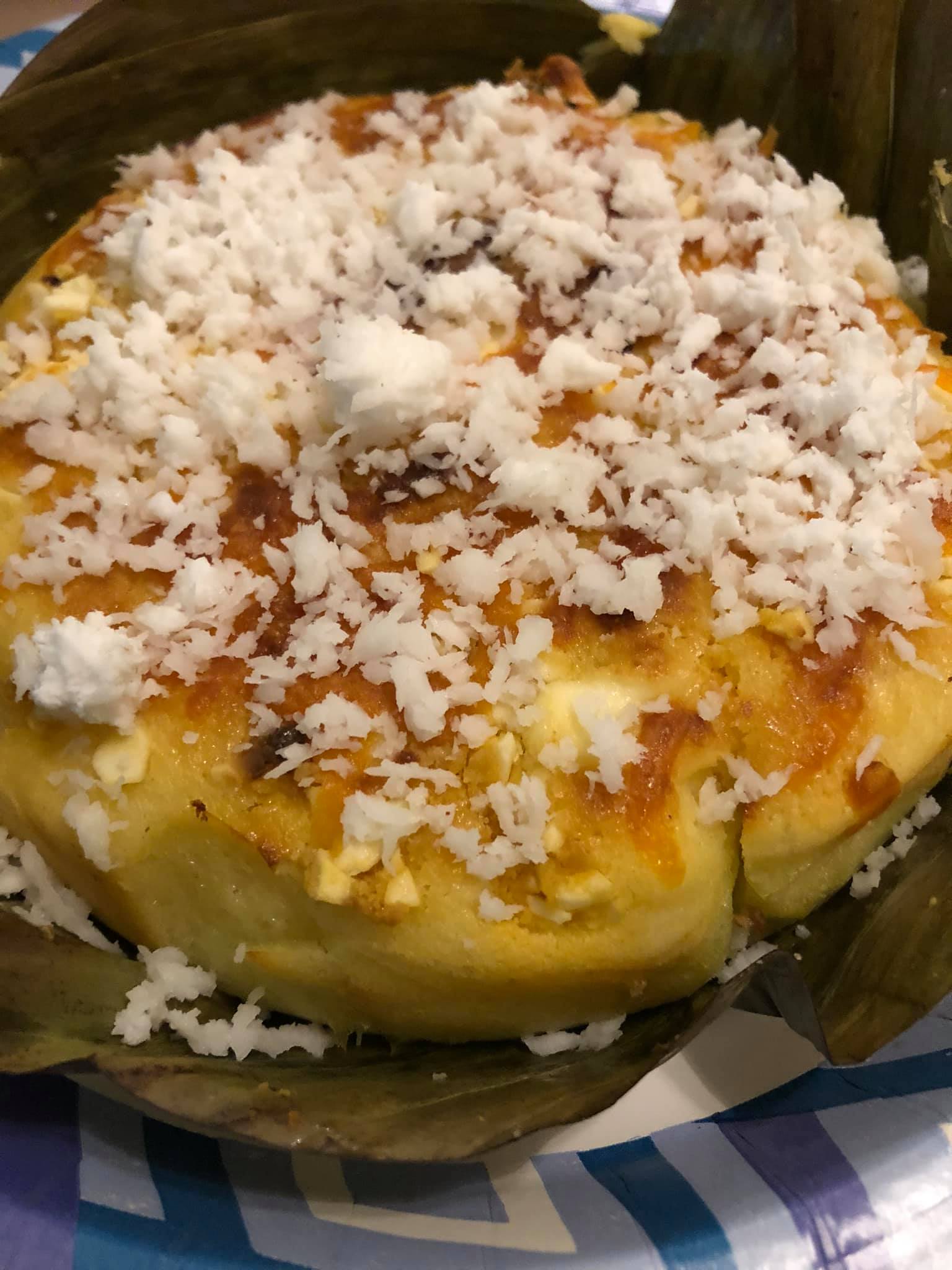
Photo source: https://www.facebook.com/authenticputobumbong/photos/3068696133450498
3. It is traditionally made from glutinous rice, soaked in water overnight in tapayan6 jars to allow it to ferment, with the addition of wild yeast called bubod7. Fermentation produces a leavening effect and provides the characteristic faint fermented aftertaste to the resulting product.
Through the use of a millstone (gilingang bato), the soaked and fermented rice is then ground into a smooth and viscous batter called galapong4.
It is also traditionally cooked in a shallow clay bowl, lined with a single large section of banana leaf. The bowl is placed over preheated coals, the batter is poured, topped with sliced salted egg (itlog na maalat) and cheese.
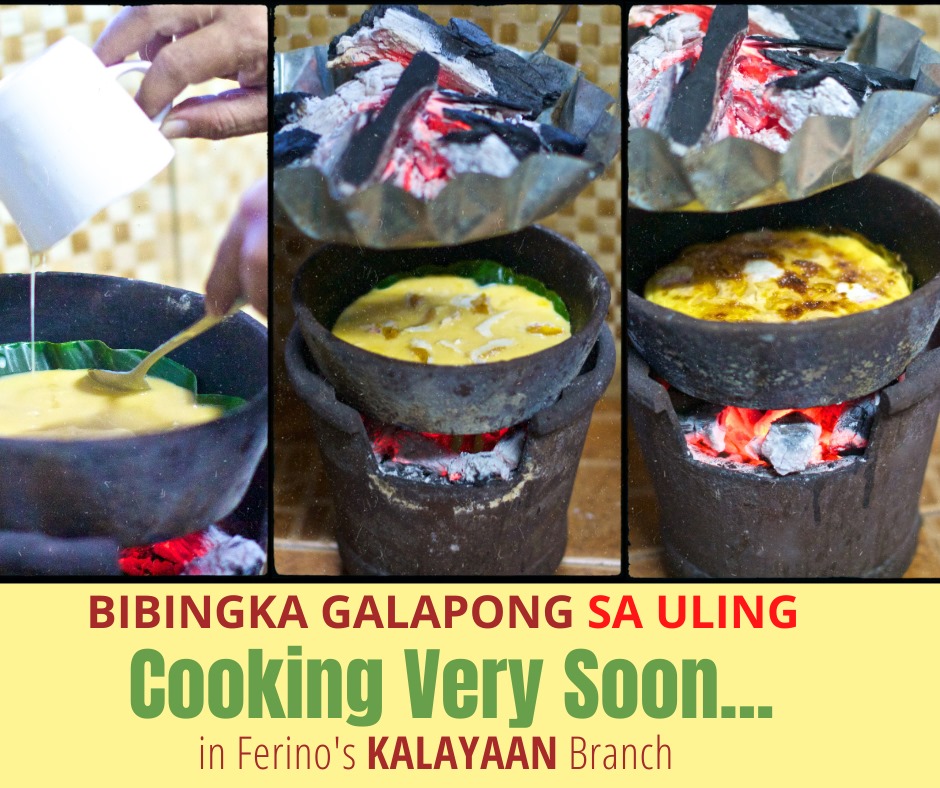
Photo source: https://www.facebook.com/ferinosbibingkaPH/photos/1751551858343822
Another piece of banana leaf is placed on top, and the container is then covered with a flat metal sheet holding more preheated coals. So the rice cake is heated both at the top and bottom, similar to an oven.
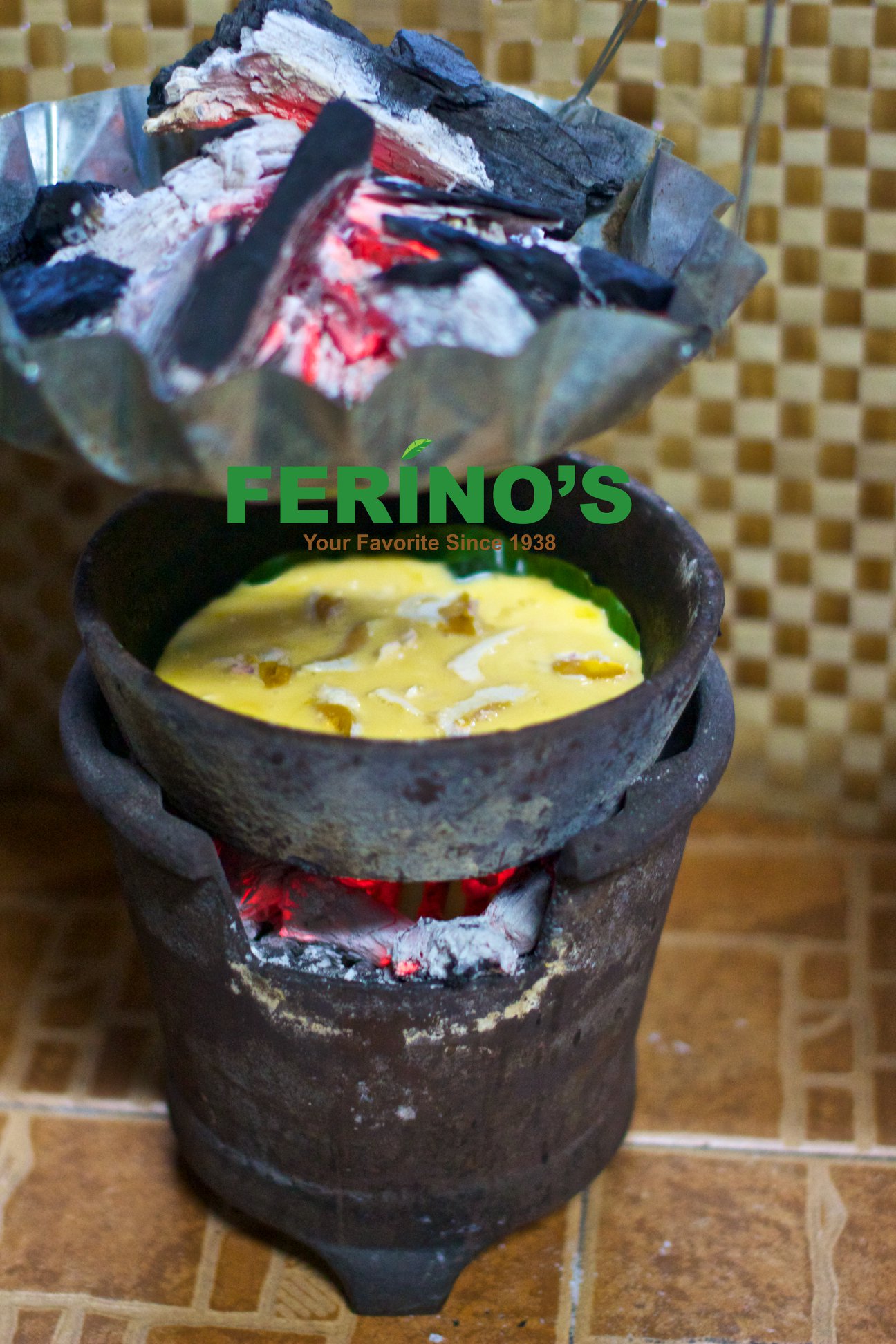
Photo source: https://www.facebook.com/ferinosbibingkaPH/photos/1656317741200568
The banana leaves not only prevent the batter from sticking to the clay pot, they also stop the hot coals from overcooking the bibingkang galapong, and add a pleasing smoky, grassy aroma to its flavor.
The toasted banana leaves at the top and bottom impart their unique subtle taste, and cause the resulting rice cake to be slightly charred on both surfaces.
The bibingka is then slathered with butter or margarine, sprinkled with white sugar, grated cheddar cheese or Edam cheese (queso de bola), and grated mature coconut (niyog).
Sizes vary from single-serve cakes to larger ones good for 3-4 persons.
4. Since the traditional preparation is so time-consuming, modern versions use regular rice flour or Japanese mochiko8 flour, instead of galapong4. Others use eggs and milk.
Metal cake pans and multi-tiered custom-made standing electric ovens are used. The resulting bibingka lacks the distinct smoky aroma of the charcoal but if banana leaves are used, the resulting product is similar to the traditional bibingka.
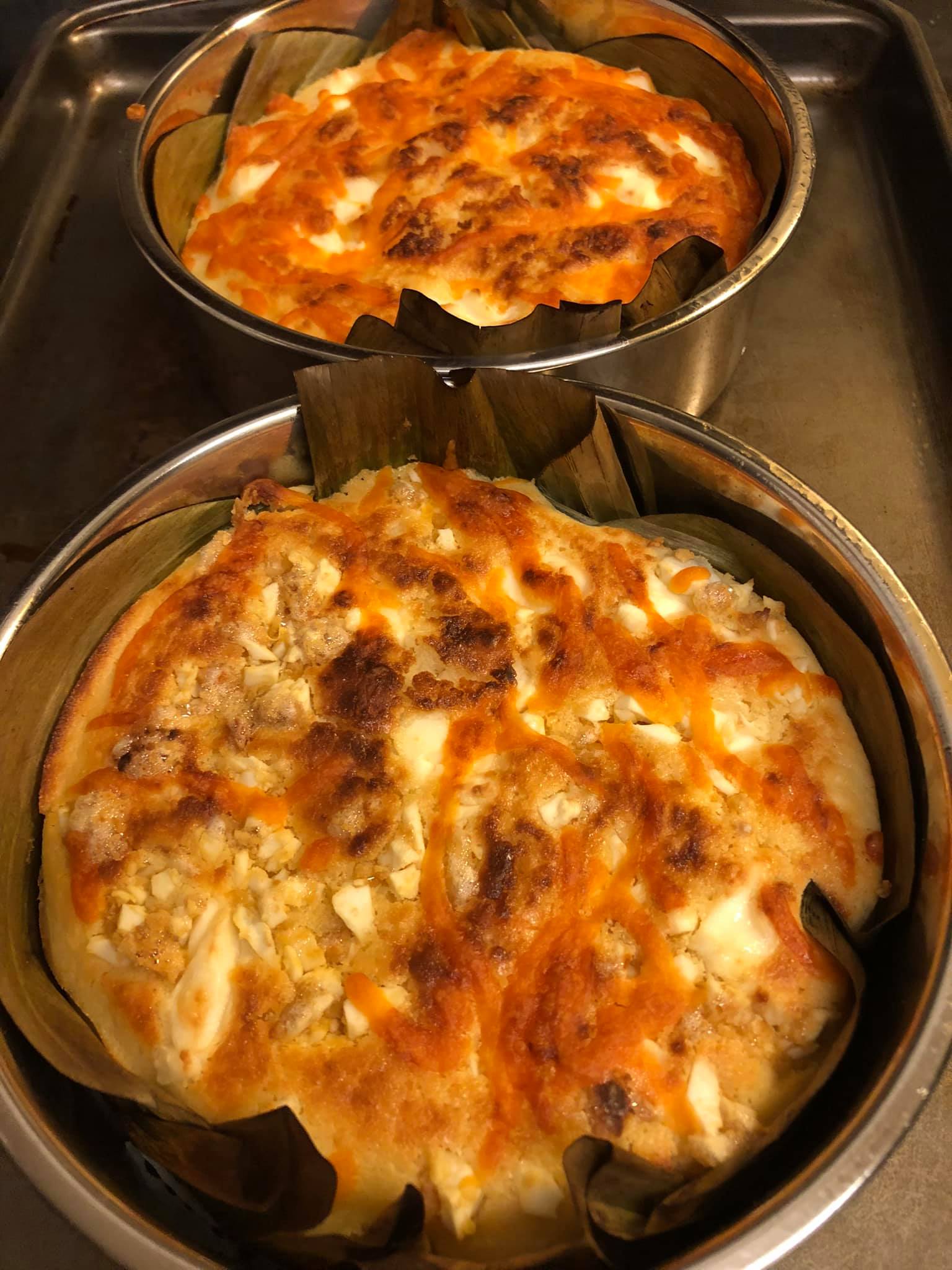
Photo source: https://www.facebook.com/authenticputobumbong/photos/3068696070117171
Modern versions use other toppings like pounded immature rice grains (pinipig), Filipino white cheese (kesong puti), chocolate, and fruit preserves or jams.
Commercially, a combination of two or more of these toppings on a single bibingka makes it special and is called bibingka especial.
5. Bibingkang galapong can be enjoyed hot or warm for breakfast, mid-afternoon snack (merienda), or as a dessert.
6. It is popularly and traditionally prepared, and sold, near the vicinity of the parish church of a town or city during the Christmas season, kept hot/warm in time for parishioners who leave the church after attending a Simbang Gabi1 mass. Filipinos eat it, along with puto bumbong2 and fresh ginger tea (salabat).
7. Bibingkang galapong is now sold all year round. There are restaurants that serve this as dessert or snack, so cravings can be easily satisfied any time of the year. But nothing beats the traditional stall near the parish church preparing and selling this native delicacy to be brought home after attending a Simbang Gabi.
8. The origin and history of bibingka is unclear. It is generally accepted that the Philippine bibingka is closely associated with the Eastern Indonesian bibingka or bingka.
The information was obtained from https://www.facebook.com/pinoyhistory/photos/bibingka-is-a-type-of-rice-cake-from-the-philippines-usually-eaten-during-the-ch/570488599828847/, https://www.sbs.com.au/food/article/2021/12/15/its-worth-waking-430am-bibingka and the Wikipedia page “Bibingka”9.
The photo featured in the cover photo-collage was obtained from Judgefloro, own work, CC0, created 15 September 2017, https://en.wikipedia.org/wiki/Bibingka#/media/File:1048Bibingka_Puto_bumbong_making_Philippines_04.jpg.
I have always enjoyed the Christmas season in the Philippines because of family gatherings, get-together with friends and colleagues, and lots of food, including native delicacies, on the buffet table.
Simbang Gabi8 is even more memorable, not only because of the inspiring sermons of the priest during the 9 days leading to Christmas day, but also due to the much awaited purchase of bibingkang galapong and puto bumbong2 from a stall right outside the church’s premises. I could not wait to get home to enjoy them with my family.
There is also the option to go to a favorite bibingka3 store called Ferino’s Bibingka. I always ask for the variant with all the extra toppings called Extra Super Bibingka, with more eggs, cheese and toppings.
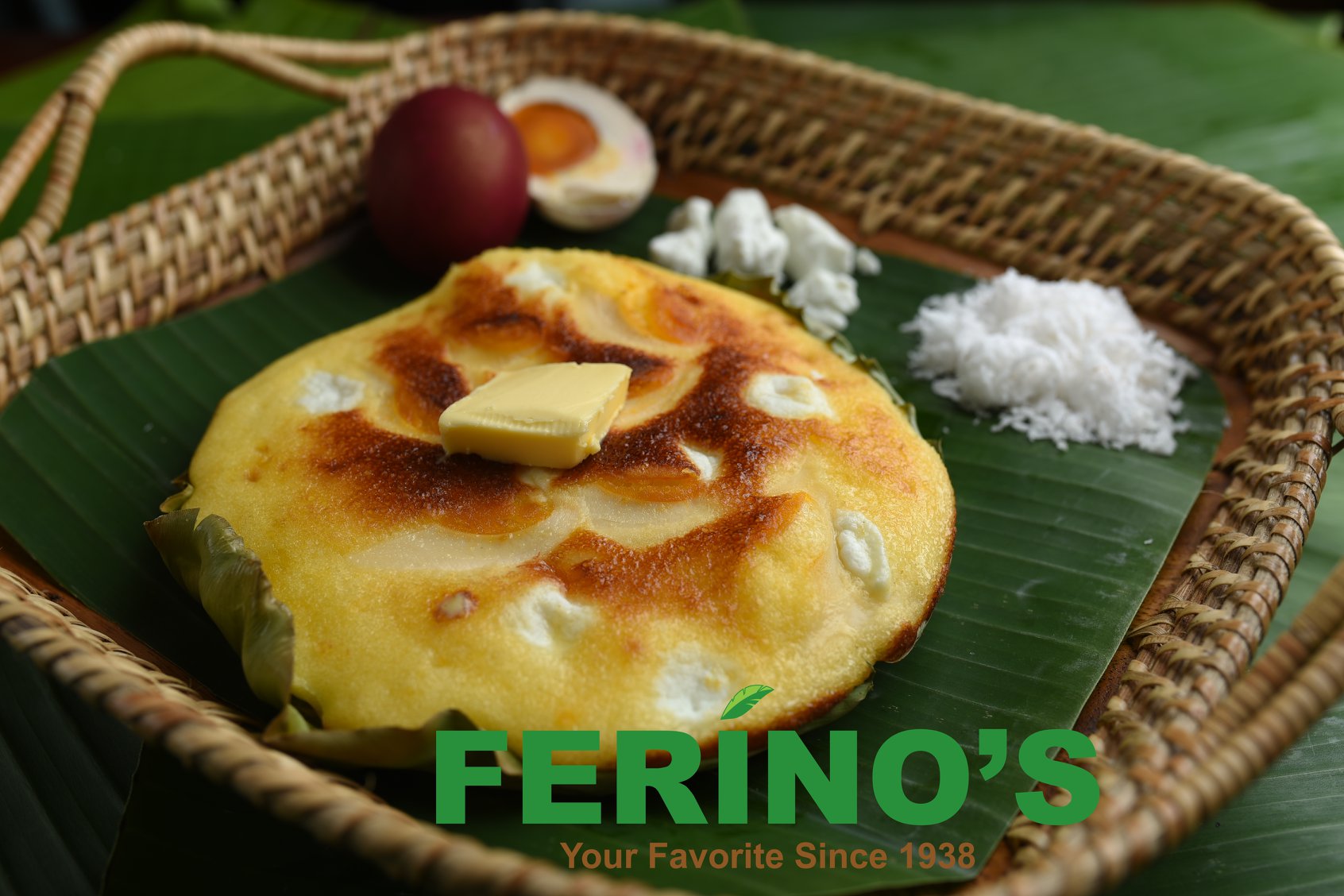
Photo source: https://www.facebook.com/ferinosbibingkaPH/photos/1656317767867232
When it is not Christmas season and I go to major malls, I find time to go to Via Mare and order their signature bibingkang galapong, with kesong puti, itlog na maalat and queso de bola.
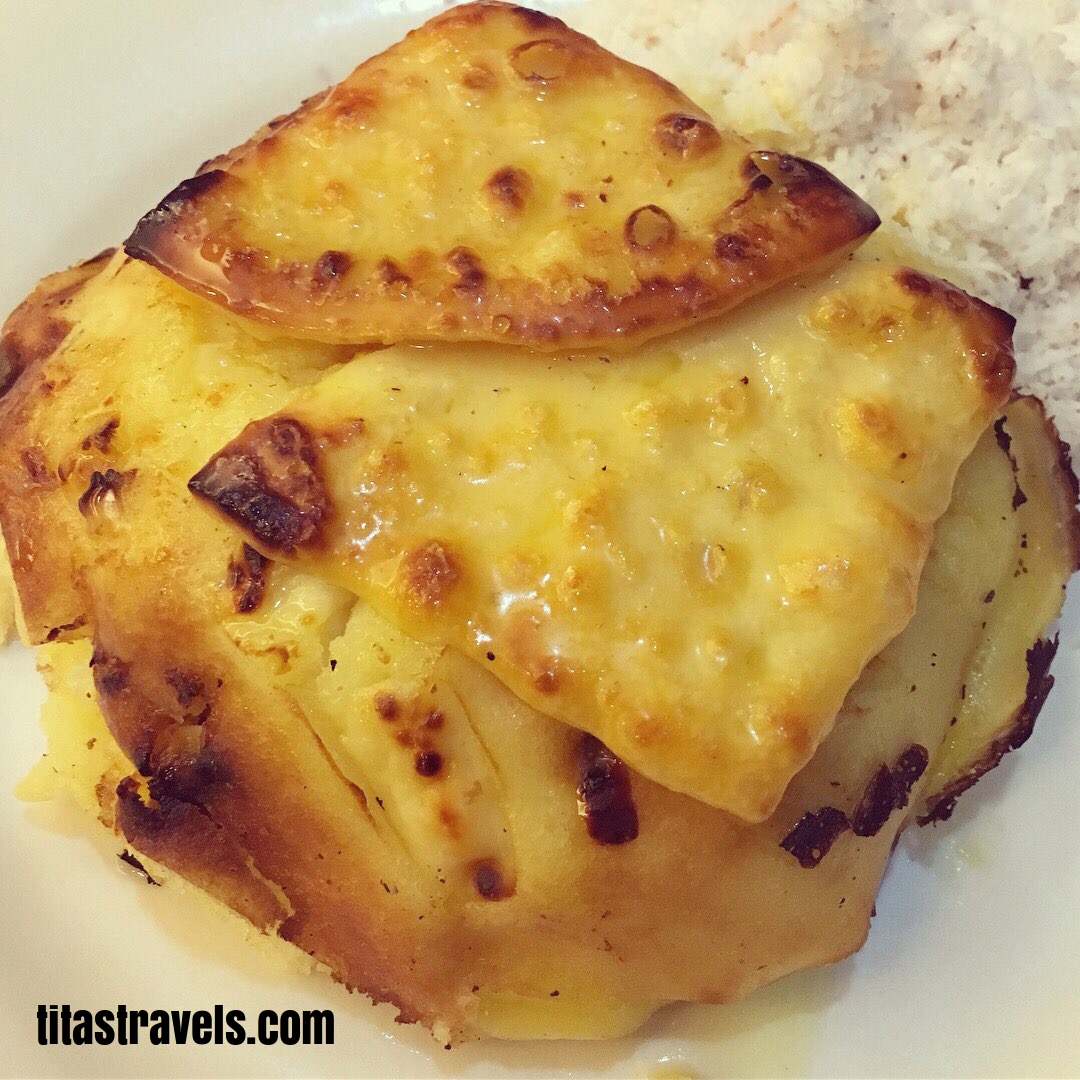
Bibingkang galapong is definitely a favorite merienda and a much-sought treat during Christmas season. I enjoy it served hot with lots of toppings, especially with queso de bola, itlog na maalat and freshly grated coconut. I wash it all down with hot chocolate. Happy tummy indeed!
Foreign readers, you have to try this native delicacy when you visit the Philippines! Filipino readers, savor bibingkang galapong this Christmas season!
There are other kinds of bibingka3 and these will be shared soon.
This is not a sponsored post. I just want my readers to know more about the Philippine delicacies.
See other interesting posts in this category and other categories – SCapades and Smart Travelers – Foreign Travelers Ask, Now You Know, and Say, Say, Say. Happy reading, and I hope that you will appreciate what I shared and some of the featured destinations will be part of your future travel plans!
Did you find this post informative? I would like to hear your comment/s regarding the bibingkang galapong, especially if you were able to try it.
Remember to share this post with your Facebook friends, follow me by clicking on the bottom right corner of your device, and do not forget to like this post. Thank you.
– – – – – – – – – – – – – – – – – – – – – – – – – –
The following terms are defined for interested readers, especially those with “Senior-Moments”, those not familiar with Filipino terms, and those too busy or lazy to Google such terms:
1Simbang Gabi (Filipino for “Night Mass”) is a devotional nine-day series of dawn masses practiced by Roman Catholics in the Philippines in anticipation of Christmas. A well-known folk belief among Filipinos is that if a devotee completes all nine days, a request made may be granted. It is the Filipinos’ spiritual preparation for Christmas.
It is similar to the nine-day series of dawn masses leading to Christmas Eve, practiced in Puerto Rico called Misa de Aguinaldo.
The information was obtained from the Wikipedia page “Simbang Gabi”.10
2Puto bumbong is a traditional, cylindrical, steamed, sticky, Filipino purple rice cake made of a combination of white glutinous rice (malagkit) and a special variety of aromatic, deep purple-brown glutinous rice (pirurutong). The information was obtained from the Wikipedia page “Puto bumbong”11.
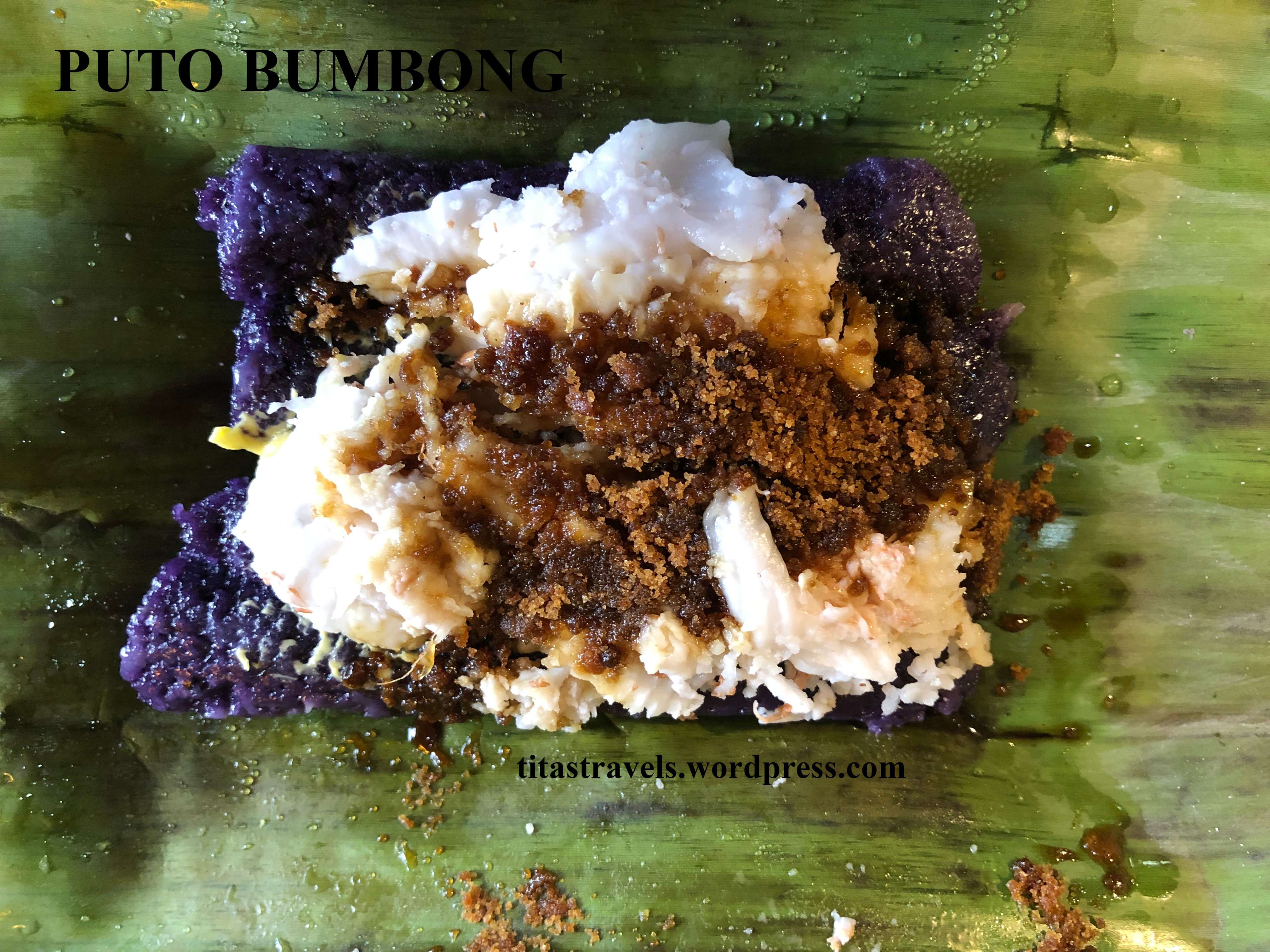
3Bibingka is a traditional rice cake in the Philippines made of rice flour, coconut milk, eggs, milk, and water, traditionally cooked in clay pots lined with banana leaves with preheated coals, top and bottom, usually enjoyed during the Christmas season, and served hot or warm for breakfast, snack, or as a dessert. Common toppings include butter/margarine, sugar, cheese, grated coconut and salted duck eggs. The information was obtained from the Wikipedia page “Bibingka”.9
4Galapong is a Filipino term for the rich and smooth viscous rice dough produced by soaking uncooked glutinous rice (malagkit) in water or coconut milk, usually allowing it to ferment overnight, then grinding it into a thick paste, traditionally using stone mills. It is often used in sweet Filipino rice cakes and desserts.
Nowadays, galapong is made directly from dry glutinous rice flour or from commercial Japanese mochiko8 (sweet rice flour), but the quality is not like the traditional method.
The information was obtained from the Wikipedia page “Rice flour”.12
5Coconut cream, or kakang gata in Filipino, is the first, thick and concentrated extraction from the grated pulp of mature coconuts. It is opaque and milky-white in appearance and is rich and creamy in flavor. It is used in Filipino native delicacies as well as savory, often spicy, dishes. The information was obtained from the Wikipedia page “Coconut milk”.13
6Tapayan, or tempayan, is a large wide-mouthed earthenware or stoneware jar found in various Austronesian cultures in Southeast Asia. It is also called balanga, belanga, or banga. It is used to: ferment wine (called tapai, thus the name), ferment vinegar or alcoholic beverages; store food and water; cook; or as burial of the deceased.
It can range in size from 30 cm (12 in) to 100 cm (3.3 ft). It typically has bulbous shoulders and a flat unadorned base. Horizontal (lug) or vertical handles may be present to a maximum of 8. The jar used to store wine can have a relatively smaller mouth and is tightly covered to prevent the alcohol from evaporating. Early tapayans were mostly unglazed, while later ones are glazed.
Tapayan also includes the imported glazed martaban stoneware, originally from kilns in Southern China and Indochina, used primarily as storage jars for foodstuffs and valuable trade goods during shop voyages, but were highly valued as trade goods too, and eventually became heirlooms and symbols of wealth and status among various indigenous cultures in the islands of Southeast Asia.
In the Philippines, tapayan is commonly used for water storage, fermentation and cooking. It is also known as kalamba or angang in Tagalog and Itawis. It is sometimes called banga or balanga to specifically refer to the jar used for storing water in traditional Filipino kitchens, and was normally kept in the banggera, the kitchen counter made of slatted bamboo that extends from the outer walls of the house. The Ilocanos, in northern Philippines, use a burnay, a tapayan with thicker walls and an airtight cover used for fermenting food products.
The information was obtained from the Wikipedia page “Tapayan”.14
7Bubod, or bobod, is the sun-dried, white to brown, oval, disc-shaped, hardened, starch powder-yeast cake made in the Ilocos region of the Philippines. It contains a mixed culture of molds, yeasts and lactobacilli bacteria which carry out the saccharification and natural fermentation process.
It acts as a natural starter culture to make a rice wine called tapuy, tapey, tapuey (Ilocano), baya or bayah (Igorot), served during special occasions like weddings, rice harvesting ceremonies, festivals and cultural fairs. Traditionally, only select people are allowed to make bubod using the Binokbok ritual.
It is made of ground sticky rice, wild ginger (unwad) roots and water. It is also made in other nearby Asian countries.
The information was obtained from https://actamanilana.ust.edu.ph/articles/volume-65/molecular-identification-of-a-native-wine-yeast-from-bubod-used-in-tapuy-fermentation/, http://dentan-nan-dalikan.blogspot.com/2013/09/how-to-make-bubod-wine-yeast.html, https://www.facebook.com/LasaExplorations/photos/a.411128573106823/473338366885843/ and the Wikipedia page “Tapuy”.15
8Mochiko, or mochigomeko, is the Japanese term for glutinous rice flour used to create mochi (a rice cake traditionally served for Japanese New Year), or as a thickener for sauces. It was traditionally made in a ceremony called mochisuki. Uncooked, this flour is often used to produce confectioneries. The information was obtained from the Wikipedia page “Mochi”.16
9“Bibingka” accessed December 18, 2021, https://en.wikipedia.org/wiki/Bibingka
10“Simbang Gabi” accessed April 2, 2018, https://en.wikipedia.org/wiki/Simbang_Gabi
11“Puto Bumbong” accessed December 18, 2021, https://en.wikipedia.org/wiki/Puto_bumbong
12“Rice flour”, accessed March 1, 2018, https://en.wikipedia.org/wiki/Rice_flour
13“Coconut milk,” accessed July 26, 2018, https://en.wikipedia.org/wiki/Coconut_milk
14“Tapayan” accessed December 18, 2021, https://en.wikipedia.org/wiki/Tapayan
15“Tapuy” accessed December 18, 2021, https://en.wikipedia.org/wiki/Tapuy
16“Mochi” accessed December 18, 2021, https://en.wikipedia.org/wiki/Mochi

